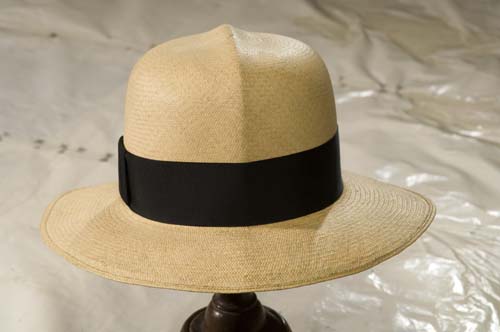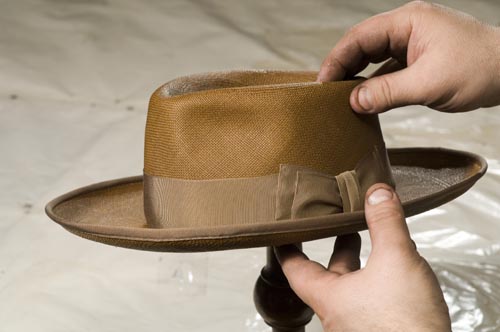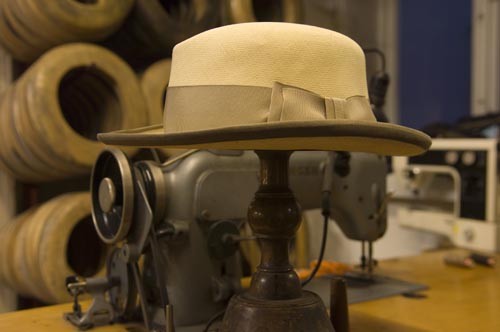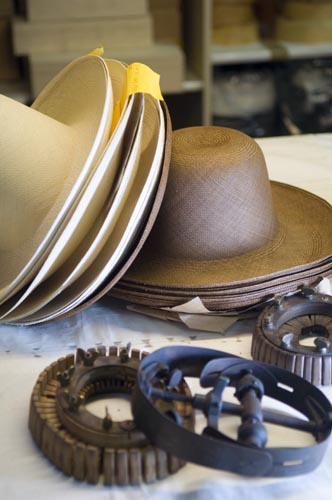 |
In the 1920s the big hit
in men´s fashion was an absolutely round straw hat. Because of this
round shape it was called in German “Kreissäge”, a circle saw. It
had originally been a sailors hat, which is why it was called a
boater in English, canotier or matelotte in French. It used to be an
indispensable item of every gentleman´s festive outfit and was not
to be missed at any dance or ball.
At work outside, in the sun and heat, it is strongly recommended to
wear a light straw hat for protection. Little children playing a lot
outside, people doing work in fields or gardens, farmers,
bricklayers, bikers, mountain climbers, and so on, would all be well
advised to wear protective headgear.
A very special straw hat is the panama-hat. The production of such a
hat is time consuming and complicated, that is why an authentic
panama-hat is quite expensive.
The panama-hat is made of the fibres of the Carludovica Palmata, the
Toquilla Palm.
In a painstaking and time-consuming procedure the thin fibres are
woven by hand, so it may well take a few months to complete the
weaving of a single hat. No wonder that some of the finest
panama-hats may cost up to a few thousand dollars. Some of the
models can even be rolled up and transported in a little box,
without being ruined.
The hats are produced by independent weavers at their homes. Mostly
these weavers also cultivate the Toquilla-plant and produce the
fibres themselves. For that process the leaves are boiled, hung up
to dry, after which the straw is dried over fire containing sulphur.
That is how the fibres, made of the torn leaves, get their light
colour. The thinner the fibre, the finer the weave turns out and
consequently the quality of the finished product.
The weaving is started from the middle. After the top is finished,
the raw product is put up on a pedestal, most of the times a stone.
The worker can now weave the sides and the brim, in the typical
position, standing on his feet, but stooped over, his breast on
another, higher pedestal.
At the end of this laborious process the ends of the fibres are tied,
overhanging straw is cut off and at last sulphur powder is carefully
hammered into the hat. Now the hat may be finished and given its
final shape over different forms, with the help of steam and
pressure. In that case it is sent on its journey as a real
panama-hat, or the unfinished product is bought up at the villages
by buyers and is then exported to factories or individual hatters
all over the world.
It is not exactly known how the hat came to be named panama-hat. It
is certain however, that the hats are made in Ecuador, not in
Panama. It seems that the weavers sold some of the hats, as
protection from the sun, to men working on the Panama-canal. Since
then, the hats which had been called “Jipi-Japa” were named
Panama-hats. It is also possible that the hats were being exported
through Panama and the name derived from that fact. Equally
plausible is the possibility that some businessman found the name
Panama-hat more attractive or more market-effective than Ecuador-hat.
Theodore Roosevelt is known to have worn such a hat when he visited
at the work-site of the Panama-canal. Many other famous men used to
wear Panama-hats. Among them were Ernest Hemingway, Winston
Churchill, Harry S. Truman, Erich Honecker, Paul Newman and Mustafa
Kemal Atatürk, the founder of “modern Turkey”. He saw the hat as a
symbol of modern times and forbade the traditional “fes”.
Nowadays too, a good straw hat is definitely indispensable to the
basic wardrobe of the well-dressed gentleman. |










